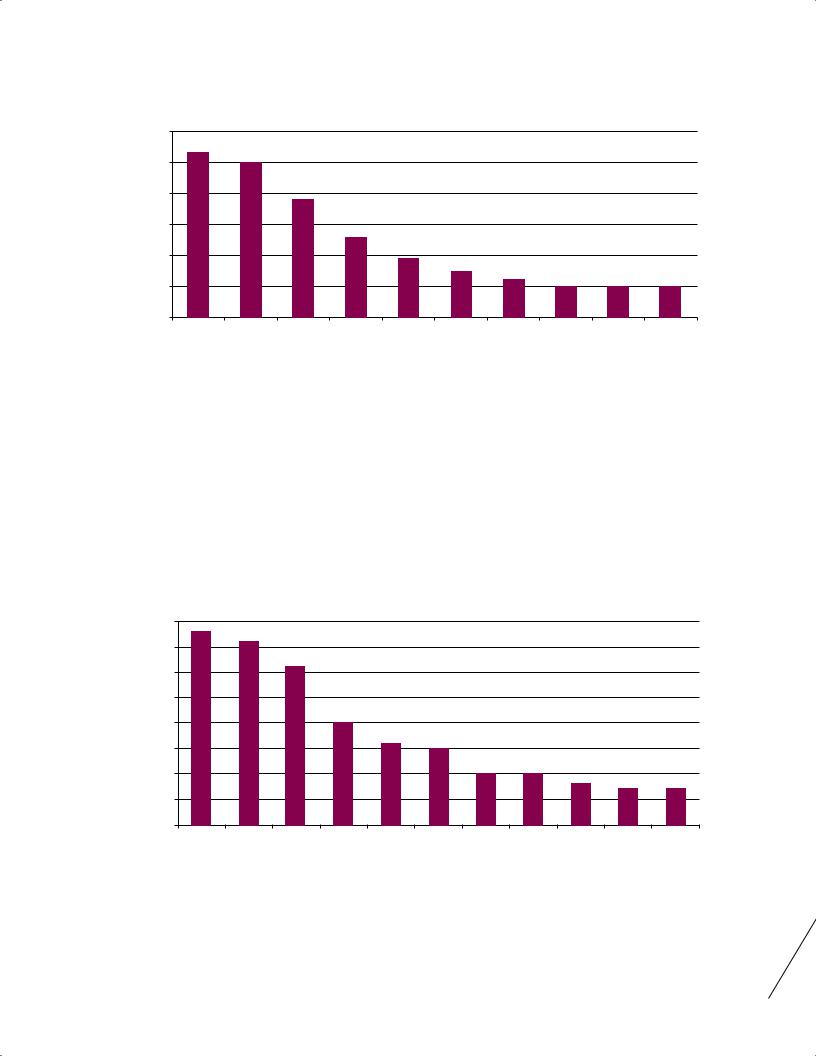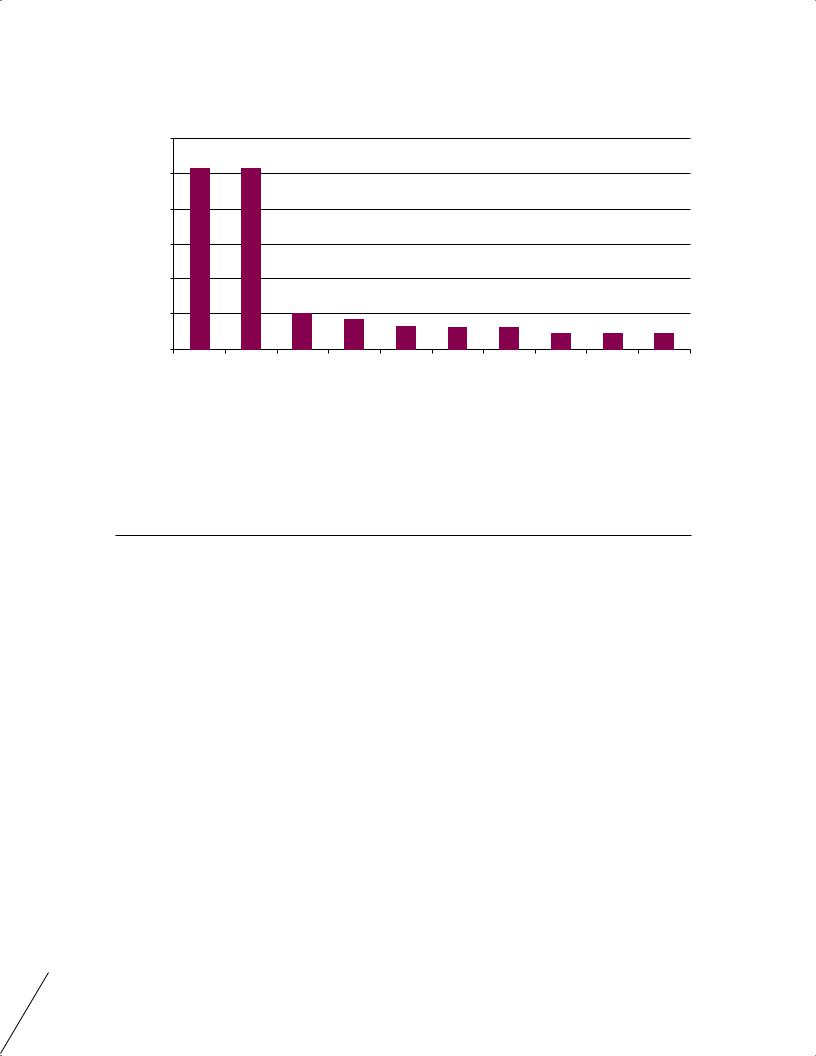
MIT-Skoltech entrepreneurial ecosystems report 2014 _1
.pdf
recommendations |
|
|
|
|
|
|
|
|
|
|
|
|
|
|
|
|
|
|
|
|
|
|
|
|
|
|
|
|
|
|
|
|
|
|
|
|
|
|
|
|
|
|
|
|
|
|
|
|
|
|
|
|
|
|
|
|
|
|
|
|
|
|
|
|
|
|
|
|
|
|
|
|
|
|
|
|
|
|
|
|
|
|
|
|
|
|
|
|
|
|
|
|
|
|
of |
|
|
|
|
|
|
|
|
|
|
|
|
|
|
|
|
|
|
|
|
|
|
|
|
|
|
|
|
|
|
|
|
|
|
|
|
|
Number |
|
|
|
|
|
|
|
|
|
|
|
|
|
|
|
|
|
|
|
|
|
|
|
|
|
|
|
|
|
|
|
|
|
|
|
|
|
|
|
|
|
|
|
|
|
|
|
|
|
|
|
|
|
|
|
|
|
MIT, |
US |
University, |
US |
Cambridge, |
UK |
London, |
UK |
of Oxford, |
UK |
Israel |
|
Diego, |
US |
Berkeley, |
US |
Switzerland |
Singapore |
|
Technion, |
|
||||||||||||||||
|
|
|
|
|
|
|
|
|
||||||||||
|
|
|
|
|
|
|
San |
UC |
|
|||||||||
|
Stanford |
of |
College |
University |
|
UC |
|
|
Zurich, |
NUS, |
|
|||||||
|
University |
Imperial |
|
|
|
|
|
ETH |
|
|
||||||||
|
|
|
|
|
|
|
|
|
|
|
||||||||
|
|
|
|
|
|
|
|
|
|
|
|
|
|
|
|
|
||
Figure 5. Top ten responses to the question supported the world’s most successful technology
‘Which universities would you identify as having created/ innovation ecosystems?’
|
|
|
|
|
|
|
|
|
|
|
|
|
|
|
|
|
|
|
recommendations |
|
|
|
|
|
|
|
|
|
|
|
|
|
|
|
|
|
|
|
|
|
|
|
|
|
|
|
|
|
|
|
|
|
|
|
|
|
|
|
|
|
|
|
|
|
|
|
|
|
|
|
|
|
|
|
|
|
|
|
|
|
|
|
|
|
|
|
|
|
|
|
|
|
|
|
|
|
|
|
|
|
|
|
|
|
|
|
|
|
|
|
|
|
|
of |
|
|
|
|
|
|
|
|
|
|
|
|
|
|
|
|
|
|
|
|
|
|
|
|
|
|
|
|
|
|
|
|
|
|
|
|
|
Number |
|
|
|
|
|
|
|
|
|
|
|
|
|
|
|
|
|
|
|
|
|
|
|
|
|
|
|
|
|
|
|
|
|
|
|
|
|
|
|
|
|
|
|
|
|
|
|
|
|
|
|
|
|
|
|
|
|
|
|
|
|
|
|
|
|
|
|
|
|
|
|
|
|
|
|
|
MIT |
|
University |
|
Cambridge |
London |
of Oxford |
Technion |
ETH |
Zurich |
|
NUS |
Germany |
UC |
Berkeley |
Sweden |
||
|
|
|
|
|
|
|
||||||||||||
|
Stanford |
|
of |
|
College |
University |
|
|
|
|
Munich, |
|
KTH, |
|
||||
|
|
|
|
|
|
|
|
|
TU |
|
|
|
|
|||||
|
|
University |
|
Imperial |
|
|
|
|
|
|
|
|
|
|
|
|||
|
|
|
|
|
|
|
|
|
|
|
|
|
|
|
||||
Figure 6. Top ten responses to the question ‘Which universities would you identify as having created/ |
|
supported the world’s most successful technology innovation ecosystems?’, with the results adjusted for country |
|
of residence of the interviewee. |
11 |

leaders world emerging from evidence :ecosystems entrepreneurial based-university creating
of recommendations |
|
|
|
|
|
|
|
|
|
|
|
|
|
|
|
|
|
|
|
|
|
|
|
|
|
|
|
|
|
|
|
|
|
|
|
|
|
|
|
|
|
|
|
|
|
|
|
|
|
|
|
|
|
|
Number |
|
|
|
|
|
|
|
|
|
|
|
|
|
|
|
|
|
|
|
|
|
|
|
|
|
|
|
|
|
|
|
|
|
|
|
|
|
|
|
|
|
|
|
|
US |
UK |
Israel |
Sweden |
Singapore |
Germany |
Switzerland |
Netherlands |
China |
Canada |
|
|
|
||||||||
|
|
|
|
|
Figure 7. The most frequently cited countries in response to the question ‘Which universities would you identify as having created/supported the world’s most successful technology innovation ecosystems?’, with the results adjusted for country of residence of the interviewee.
4.2. The most effective university-based ecosystems despite a challenging environment
All experts were asked to identify the universities that they felt created/supported an effective technology innovation ecosystem despite a challenging environment (see question 3 in Figure 3). In response to this question, experts identified a total of 131 different universities across 35 countries. The institutions/ ecosystems most frequently cited are detailed in Figure 8.
Figure 8 points to a wider spread of views, and without the dominance of a few institutions that emerged from the experts’ assessments of the universities most successful in facilitating technology innovation ecosystems (Figure 5).
When discussing the perceived challenges faced by the universities being recommended, experts were most likely to identify the following factors: (i) a national culture that does not support entrepreneurial behaviour and risk-taking, (ii) geographical isolation and/or limited local market, (iii) lack of venture capital or multinational companies in the region, and (iv) no existing high-ranking research-led university within the ecosystem base.
Figure 9 presents the data on the most highly-regarded universities by their country location, with account taken of the country of residence of the experts.
12

recommendations |
|
|
|
|
|
|
|
|
|
|
|
|
|
|
|
|
|
|
|
|
|
|
|
|
|
|
|
|
|
|
|
|
|
|
|
|
|
|
|
|
|
|
|
|
|
|
|
|
|
|
|
|
|
|
|
|
|
|
|
|
|
|
|
|
|
|
|
|
|
|
|
|
|
|
|
|
|
|
|
|
|
|
|
|
|
|
|
|
|
|
|
|
|
|
|
|
|
|
|
|
|
|
|
|
|
|
|
|
|
|
|
|
|
|
of |
|
|
|
|
|
|
|
|
|
|
|
|
|
|
|
|
|
|
|
|
|
|
Number |
|
|
|
|
|
|
|
|
|
|
|
|
|
|
|
|
|
|
|
|
|
|
|
|
|
|
|
|
|
|
|
|
|
|
|
|
|
|
|
|
|
|
|
|
|
|
Israel |
|
|
France |
|
Zealand |
|
Finland |
|
UK |
|
Korea |
China |
Russia |
|
US |
||||||
|
|
|
|
|
|
London, |
|
Michigan, |
||||||||||||||
|
Technion, |
|
|
|
|
|
Kaist, |
|
||||||||||||||
|
|
Antipolis, |
|
New |
|
University, |
|
College |
|
|
University, |
TUSUR, |
|
of |
|
|||||||
|
Sophia |
|
|
Aalto |
|
|
|
|
|
|
|
|
|
|
||||||||
|
|
of |
Auckland, |
|
|
Imperial |
|
|
Tsinghua |
|
University |
|
|
|
||||||||
|
University |
|
|
|
|
|
|
|
|
|
|
|
|
|||||||||
|
|
|
|
|
|
|
|
|
|
|
|
|
|
|||||||||
|
|
|
|
|
|
|
|
|
|
|
|
|
|
|
|
|
|
|
|
|||
Figure 8. Top responses to the question ‘Which universities would you identify as having created/supported highly effective technology innovation ecosystems despite a challenging environment?’4
|
|
|
|
|
|
|
|
|
|
|
|
recommendations |
|
|
|
|
|
|
|
|
|
|
|
|
|
|
|
|
|
|
|
|
|
|
|
|
|
|
|
|
|
|
|
|
|
|
|
of |
|
|
|
|
|
|
|
|
|
|
|
|
|
|
|
|
|
|
|
|
|
|
|
Number |
|
|
|
|
|
|
|
|
|
|
|
|
|
|
|
|
|
|
|
|
|
|
|
|
|
|
|
|
|
|
|
|
|
|
|
|
Israel |
US |
China |
UK |
Finland |
France |
Australia |
Chile |
Zealand |
Singapore |
Sweden |
|
|
|
|||||||||
|
|
|
|
|
New |
||||||
|
|
|
|
|
|
|
|
|
|
|
Figure 9. The most frequently cited countries in response to the question ‘Which universities would you identify as having created/supported highly effective technology innovation ecosystems despite a challenging environment?’, with the results adjusted for country of residence of the interviewee.
4 It should be noted that Sophia Antipolis was one of the few expert recommendations that described a technology park rather |
13 |
than a university. |

leaders world emerging from evidence :ecosystems entrepreneurial based-university creating
14
5.Success factors for the most highly-regarded universities/regions
After their recommendations for the world-leading university-based ecosystems were recorded (see section 4), experts were asked to discuss their reasons for these selections and the factors perceived to underpin the universities’ success. This section provides a brief summary of their responses.
5.1. Broad feedback on the top-ranked universities
When asked to describe the world’s most highly-regarded universities, experts often described the institutions using one of the following three characterisations:
1.Universities that had benefitted significantly from a “rising tide that floats all boats” at a national/ regional level or from very significant government subsidies. In other words, the university is seen to have played a relatively limited role in the development of the ecosystem; instead its
success is largely credited to contextual factors, such as strategic government policy/investment, a strengthening national economy or the influx of new entrepreneurial talent.
2.Universities whose strong international reputation for knowledge transfer is not necessarily supported by evidence of their performance. Some universities were described by experts as
“presenting some good-looking numbers and talking the talk” but were regarded, on closer inspection, to have relatively limited entrepreneurial activities and made a relatively modest contribution to their regional ecosystem.
3.Universities who had played an active, positive role in a vibrant and strengthening ecosystem. In other words, the success of the universities was viewed to have been genuinely a product of
effective university-based strategies/activities rather than circumstance or national/regional fortune.
It is the strategies and approach of the universities within the third of these groups that are likely to provide the greatest insight into the design of future ecosystems. Expert feedback highlighted, in particular, universities whose distinctive path in their E&I policy was designed in response to the particular barriers faced in their environment.
Many experts also observed that the ecosystem rankings emerging from this study should not be considered to be static. With an increasing engagement with the E&I agenda, they reported a rapid improvement in the impact and reputation of many universities and the likely emergence of “new leaders from outside the US” in the coming five to ten years.
The continuing dominance of MIT and Stanford, however, was not questioned. These institutions were seen by almost all experts to be “far and away the world leaders”. Their long-standing success did lead a number of experts to observe that universities wishing to emulate the fortunes of MIT and Stanford
“would be much better off studying their early history than trying to copy what they are doing now”. Expert feedback also highlighted a number of “emerging giants”, such as Technion and Imperial College London, whose reputation had grown considerably in recent years.
Finally, experts spoke about the “rising stars” – universities whose current trajectory suggested a strong international presence in the future. Examples consistently identified by experts included the University of Auckland, Aalto University and the University of Michigan. A number of universities in China and Brazil were also discussed in this context, although no particular universities dominated amongst

the spread of recommendations made within each country. Although many US-based experts noted considerable interest in the early ecosystem development in New York (“young entrepreneurs are flocking there”), most also commented that it was “too early to say whether this will come together”.
5.2. Success factors amongst the leading universities
Experts were asked to identify the factors underpinning the success of their selected universitybased ecosystems. Their responses painted a rich and often very consistent picture of the elements
contributing to ecosystem impact and reputation in each case. When looking across these descriptions, seven types of success factor were repeatedly highlighted by experts. Each is briefly discussed below.
•Institutional E&I culture: Institutional E&I culture was almost universally described by experts as an “essential” ingredient of a successful ecosystem. For a number of the world-leading universities, their E&I ethos was seen to have been either “sewn into the fabric of the universities from their very foundation” (as credited to MIT and Stanford) or as having benefitted from a national “ethos to make
things happen” (as credited to Technion). However, most of the feedback focused on other universities and the challenges they faced in catalysing a change in their E&I culture. Many experts noted that
“British universities are the most interesting examples” of those that had successfully implemented such a change. As one expert explained, “…they had excellent universities, but no venture industry, no internal industry and not much entrepreneurial spirit. They have been able to overcome a lot of this”. The University of Cambridge was noted as a primary, and on-going, example of a university whose successful cultural change was challenged by “800 years of history” and “active hostility to setting up technology transfer activities”. Through celebrating the achievements of faculty role models, a relatively unstructured mix of E&I activities across campus, and a freedom for faculty to devote time to entrepreneurial ideas, the university is now seen to enjoy an increasingly entrepreneurial culture.
•Strength of university leadership: The names of particular university leaders were repeatedly raised as playing a pivotal role in establishing a strong E&I strategy and sowing the seeds of a vibrant university ecosystem. Some such individuals were seen as the driving force behind the establishment of new ecosystems from a greenfield site – such as the case of Pierre Lafitte at Sophia Antipolis. However, more frequently identified were leaders associated with changes in previously underdeveloped ecosystems. They were credited with enacting a fundamental change in university E&I culture and strategy that led to a significant strengthening of ecosystem performance. For example, a name strongly associated with the strengthening E&I reputation of Imperial College London was Richard Sykes, who served as university Rector between 2001 and 2008. Previously CEO of GlaxoSmithKline, Richard Sykes was seen to bring a culture of “celebrating the success of entrepreneurs, sending the message that academics can get rich without losing their credibility as a world class researcher”. Richard Sykes also exerted pressure on the existing technology transfer office, Imperial Innovations, to “demonstrate the value of their activities”. In the years that followed, Imperial Innovations was transformed into “something very unique – an independent company that handles the whole technology transfer process for the university”.
•University research capability: Many universities in the expert rankings have a long history as international research powerhouses, and this quality and capacity was seen as a cornerstone of the ecosystem’s success. For example, at ETH Zurich, the university’s “long-standing history of excellence in research” with a considerable international focus was noted by experts as key to the ecosystem’s strength.
•The local or regional quality of life: The attraction of the locality itself was seen as a major benefit
to ecosystem growth. For example, many experts described the “gorgeous location” of Sophia |
15 |

leaders world emerging from evidence :ecosystems entrepreneurial based-university creating
16
Antipolis as the “key to its success”. As one commented, “…it sounds trivial, but location and lifestyle is a big factor. They were taking the Silicon Valley summery lifestyle and setting it up in the south of France”. The design of the park itself was also seen as an influencing factor – “… it is not a science park as you would expect. The buildings are scattered throughout the hills. It is like nothing else I have seen”. The pre-existing tourist industry also made the region “open to the world”, with international schools, an international airport and high-speed train lines to the rest of Europe.
•Regional or government support: Many universities featured in the expert rankings have clearly benefitted from significant external support for ecosystem development in the form of generous government subsidies and advantageous regional policies. In some cases, experts observed that these interventions allowed universities to present a highly successful façade that masked an ineffective or very limited E&I contribution by the institution itself. However, experts also highlighted a significant number of cases where regional or government interventions had achieved much more positive and sustainable results. For example, the collaborations across universities, business and local government in the city of Tomsk, Siberia, were seen as a major factor in the emerging E&I environment at Tomsk State University of Control Systems and Radioelectronics (TUSUR). When describing the growing vibrancy of this university ecosystem,
one expert commented, “[TUSUR] did not do this alone. There was an openness between the university and the [rest of the] ecosystem. They have combined the general city facilities with the university facilities with business facilities”. Through this mutually-reinforcing collaboration, the city is seen to have become open and attractive and a place where “entrepreneurs would want to move their ideas”.
•Effective institutional strategy: Experts described at length the university strategies associated with successful ecosystem growth. Some effective strategies appeared to be relatively independent of the university size, location and profile. Examples included approaches where the institutional focus for E&I did not reside within a single group or centre, but was allowed to emerge as multiple, and often unconnected, activities operating across and beyond the campus. Other strategies described were specifically tailored to the university context, often in direct response to the challenges faced in that environment. For example, the size and geographical isolation of New Zealand together with the absence of multinational companies led the University of Auckland to develop a strategy of “associating our capabilities with the needs of other nations”. Experts pointed, in particular, to the performance of UniServices, an autonomous but university-owned institution managing all research contracts and commercialisation activities for the University of Auckland. UniServices have focused on the development of long-term strategic partnerships with large multinational companies and carefully positioned themselves “in specific segments and markets”. One expert described how they had created “a support environment in New Zealand that allows people to think globally about their business”.
•Powerful student-led entrepreneurship drive: “Student energy in entrepreneurship” was viewed by experts as an increasingly prominent driver of ecosystem development, particularly amongst emerging ecosystems and those operating in more challenging environments. One university highlighted by experts in this context was the recently established Aalto University in Helsinki. The university was formed through the merger of three highly-regarded schools of business,
engineering and design, with an explicit focus on “innovation based entrepreneurship”. Many experts commented that, after only two years of operation, the “levels of student engagement [in E&I] are phenomenal”, supported by an array of activities and resources across campus. The decreasing dominance of the major employers of Finnish graduates, such as Nokia, was also seen to have supported a wave of interest in entrepreneurial careers amongst student populations within the country, with emerging national role models such as the developers of Angry Birds.5
5 Angry Birds is a video game developed in Finland in 2009

6. Data to characterise each top-ranked university
This section presents a range of data through which it is possible to characterise and compare the profiles, E&I approaches and research commercialisation performances of ten of the most highlyregarded universities emerging from the study.
The universities considered are:
•Aalto University (Finland)
•University of Auckland (New Zealand)
•University of Cambridge (UK)
•Imperial College London (UK)
•University of Michigan (US)
•MIT (US)
•University of Oxford (UK)
•Stanford University (US)
•Technion (Israel)
•UC San Diego (US)
The data for these universities is presented in Figure 10. Most of the information has been gathered from publicly available sources. Where not available in the public domain, data was requested directly from the universities concerned. National and institutional differences in data collection procedures, performance metrics and reporting periods, however, mean that the data are unlikely to be strictly comparable. With this caveat, Figure 10 provides an overview of the broad differences and similarities between the ten universities. Further information is provided in Appendix E, including more detailed definitions of the metrics reported in Figure 10 as well as data sources and details of relevant ecosystem components for each of the ten universities.
Unless otherwise indicated, all data relate to the year 2013. For all non-US institutions, financial information has been converted to US Dollars, using the exchange rates detailed in Appendix E.
The commercialisation data for nine of the ten universities6 has been checked and approved by a representative of each institution concerned.
17
6 Commercialisation data corresponding to Stanford University has not been checked by the university

leaders world emerging from evidence :ecosystems entrepreneurial based-university creating
|
University profile |
Aalto |
Auckland |
Cambridge |
Imperial |
Michigan |
|
|
University ranking |
|
|
|
|
|
|
|
|
|
|
|
|
|
|
|
Expert rating for the most successful ecosystemsa |
>20 |
>20 |
3 |
4 |
15= |
|
|
Expert rating for effective ecosystems in adverse env.a |
4= |
2= |
>20 |
4= |
4= |
|
|
THE World University Rankings 2013/14 |
301-350 |
164= |
7 |
10 |
18 |
|
|
QS World University Rankings 2013/14 |
196= |
94 |
3 |
5 |
22 |
|
|
|
|
|
|
|
|
|
|
Institutional size and budget |
|
|
|
|
|
|
|
University revenue (USD) |
$581m |
$801mc |
$2.5b |
$1.4b |
$5.3b |
|
|
University endowment (USD) |
$1.3b |
$49mc |
$1.8b |
$160m |
$8.4b |
|
|
Sponsored research income (USD) |
$68m |
$197mc |
$542m |
$547m |
$1.3b |
|
|
Industry sponsored research income (USD) |
$31m |
$63mc |
$49m |
$66mc |
$72m |
|
|
Number of undergraduate students (fullplus part-time) |
19,993 |
26,915b,c |
12,140 |
8,810 |
28,283 |
|
|
Number of graduate students (fullplus part-time) |
1,711 |
5,686b,c |
7,245 |
7,195 |
12,724 |
|
|
Number of academic faculty |
366 |
2,160b,c |
4,915 |
3,825 |
3,059 |
|
|
E&I approach |
|
|
|
|
|
|
|
Are there university centres actively promoting E&I? |
|
|
|
|
|
|
|
Are E&I courses offered to students across campus? |
|
|
|
|
|
|
|
Are there university-wide E&I competitions? |
|
|
|
|
|
|
|
Are there E&I student clubs and societies? |
|
|
|
|
|
|
|
Does the university offer seed funding? |
|
|
|
|
|
|
|
Does the university offer proof of concept funding? |
|
|
|
|
|
|
|
Does the university offer an accelerator/incubator? |
|
|
|
|
|
|
|
Default IP ownership for government funded research? |
University |
University |
University |
University |
University |
|
|
Default IP ownership for industry funded research? |
Industry |
Industry |
University |
University |
University |
|
|
Do they offer support to other ecosystems? |
|
|
|
|
|
|
|
Are external E&I bodies actively driving the ecosystem? |
|
|
|
|
|
|
|
|
|
|
|
|
|
|
|
Research commercialisation |
|
|
|
|
|
|
|
|
|
|
|
|
|
|
|
IP disclosures per year |
150 |
128 |
124 |
329 |
421 |
|
|
Patents filed per year (all fillings, all jurisdictions) |
53 |
21 |
204 |
90 |
395 |
|
|
Patents issued per year |
10 |
23 |
48 |
67 |
130 |
|
|
Number of licences per year |
5 |
22 |
76 |
32 |
108 |
|
|
Number of licences to spin-outs per year |
6 |
3 |
11 |
4 |
9 |
|
|
Licensing revenue per year |
$250k |
$13m |
$7m |
$2.3m |
$13.4m |
|
|
IP expenses per year |
$400k |
$0.7m |
$2.1m |
$1.9m |
$7m |
|
|
|
|
|
|
|
|
|
aFrom expert consultations in Phase 1 of this study (n=61)
bFull-time equivalent (rather than headcount, part-time plus full-time, as for other universities
cData from 2012
Figure 10. Comparative information to characterise the institutional profile, E&I approach and research commercialisation activity of ten universities identified as highly-regarded in this study. All data refers to the year 2013 unless otherwise stated. Further information is provided in Appendix E.
18

|
MIT |
Oxford |
Stanford |
Technion |
UCSD |
|
|
|
|
|
|
|
1 |
5 |
2 |
6 |
7 |
|
>20 |
>20 |
>20 |
1 |
>20 |
|
5 |
2= |
4 |
201-225 |
40= |
|
1 |
6 |
7 |
183= |
63 |
|
|
|
|
|
|
|
|
|
|
|
|
|
$3.2b |
$1.8b |
$4.1b |
$678m |
$3.0bc |
|
$11b |
$1.1b |
$18.7b |
$1.6b |
$642m |
|
$674m |
$725m |
$1.2b |
$84m |
$985m |
|
$106m |
$93m |
- |
$7m |
$120m |
|
4,528 |
16,745 |
6,980 |
9,754 |
23,805 |
|
6,773 |
8,925 |
8,897 |
3,499 |
6,505 |
|
1,030 |
5,965 |
1,429 |
616 |
1,196 |
|
|
|
|
|
|
|
|
|
|
|
|
|
|
|
|
|
|
|
|
|
|
|
|
|
|
|
|
|
|
|
|
|
|
|
|
|
|
|
|
|
|
|
|
|
|
|
|
|
|
|
|
|
|
|
University |
University |
University |
University |
University |
|
University |
University |
University |
University |
University |
|
|
|
|
|
|
|
|
|
|
|
|
|
|
|
|
|
|
|
|
|
|
|
|
|
698 |
326 |
502 |
81c |
296c |
|
932 |
197 |
613c |
235c |
322c |
|
290 |
119 |
201c |
89c |
164c |
|
68 |
105 |
103 |
6c |
60c |
|
16 |
8 |
9 |
8c |
12c |
|
$70m |
$14m |
$87m |
$22mc |
$16.2mc |
|
$19m |
$5.1m |
$9.3m |
$1.6mc |
$1.9mc |
|
|
|
|
|
|
19

phase 2 
CASE STUDIES
OF WELL-REGARDED PRACTICE
20
